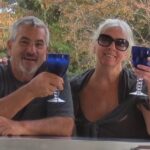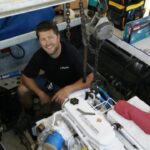Cummins Marine Diesel Repower Specialists › Forums › Cummins Marine Engines › Thoughts on continuous duty QSM11
- This topic has 9 replies, 4 voices, and was last updated 6 years ago by
 Tony Athens.
Tony Athens.
-
CreatorTopic
-
October 17, 2017 at 10:01 am #24006
Peter HaydenParticipantI’m building a 70′, 100ton full displacement trawler that will operate in the 8-9kt range. Power options are a 13l Deere, 13l Scania, or QSM11. All are continuous duty ratings at +/-400hp, 1800 RPM. Usage in the 500-1000 hrs/year range.
I’m interested in thoughts on the QSM11 in such an application, and how it would compare to the Deere and Scania.
I’m all ears.
Thanks
-
CreatorTopic
-
AuthorReplies
-
October 29, 2017 at 10:56 am #24396

Tony AthensModeratorVessel Name: Local Banks
Engines: QSB 6.7 550 HP
Location: Oxnard, CA
Country: USA
What you want to do would require some very custom engineering.. The factory drive option for the alternator would never allow a 4500+ Watt alternator to work running on a single small serpentine belt.. You , need at a minimum, a 2-groove properly design V-belt drive system for an alternator of that capacity…All doable, but not for the timid or in-experienced to tackle.. An example attached. This is a Delco 34SI/24~28VDC . Cummins offers zilch that way.
Tony
October 27, 2017 at 6:18 pm #24360
Peter HaydenParticipantThanks Tony, that is super helpful and answers the questions I had.
One thing I will want to do on this engine is outfit it with dual, high capacity alternators. They would be Leece Neville 175A or 200A @ 24V. I’m guessing one could replace the usual alternator? And what’s the best way to attach the second? Would it have to be all custom, or does Cummins offer any bracket sets?
October 27, 2017 at 5:07 pm #24354
Tony AthensModeratorVessel Name: Local Banks
Engines: QSB 6.7 550 HP
Location: Oxnard, CA
Country: USA
Maybe this will help:
1) The term WET QSM is kinda what I use to differentiate that version from the other one that I call DRY.. Cummins does not use this terminology.
The REAL difference is how the basic engine is configured as to the manifold design & turbo design/ arrangement.. The WET QSM uses a COOLANT COOLED TURBO and a COOLANT JACKETED exhaust Manifold–IMO, Like all true marine diesels engine should have
The DRY QSM has a Dry Turbo & Dry Exhaust manifold–EXACTY like a truck has. The only real difference, the dry version has a heat shield covering them to help keep the heat from radiating to the engine room and close by components.
2) Ratings available— The WET version is available from 300 to 450 HP and can be used commercially or as a pleasure boat engine.
The dry version comes in 600 to 715 HP. Only the 600 version can be used commercially but only in a INT duty cycle ( light duty )3) Engine cooling: The dry version only comes as a heat exchanged cooled engine with a SEAWATER cooled aftercooler–The engine has a large rubber impeller type seawater pump like all most HX engines on this size range & design………………………………………The WET version can be set up for HX cooling or as a KC engine. The HX version is straight forward and common in the base design as to the circuit.. The KC version is somewhat unique but is super simple. It uses the same aftercooler as the HX engine ( designed for seawater) but because the engine is now keel cooled and that cooler is so efficient, it only needs a single circuit KC system.. The coolant from the engine is pumped to the KC via the engines coolant pump and returns from the KC to the after cooler first, and then to the engine coolant pump inlet.. Really simple and 100% long term as now the aftercooler operates a JWAC engine it has engine coolant it in.. By far the best of both worlds..
Either engine can have a dry exhaust or wet exhaust system ( after the turbo).
4) With the KC version, you can have 2 built in PTO’s if ordered properly–
(1) SAE A or B pad
and
(1) Stub shaft that is real easy to adapt most anything to.. Both are gear driven
Hope this helps.
If you end up going this direction, be sure the person you work with knows this engine as there are many options for commercial applications available that even my own distributor has no clue of.
One more thing to consider is support–This exact base engine has been “on-highway” in this country for over 30 year now, so you are in good company as to parts and service availability.. No other make engine that competes in this arena comes close.
Tony
1 user thanked author for this post.
October 26, 2017 at 9:25 pm #24316Going to dip my toe in here….hopefully I can delete if I am totally wrong.
Keel cooling with regards to aftercoolers covers a couple options, JW (jacket water) keelcooling is a single circuit where the block and aftercooler share the same circuit. Or, LTA (low temperature aftercooling), LTA refers to a totally separate dedicated keelcooling loop for the aftercooler, not shared with the engine.
If you are going for a heat exchanger, I would assume you would go SWAC, but that is just a guess.
Our 6BTA has a keelcooler for the engine, and seawater system for aftercooler. Our D13 Volvo has two keelcoolers, one for the engine, one for the aftercooler.
My 2 cents, Tony can correct me if I am way off base I will crawl back to lurker status:)
I would assume WET QSM always means coolant cooled manifold and turbo, but certainly check with your distributor.
October 26, 2017 at 8:39 pm #24315
Peter HaydenParticipantThanks. So just to be clear, by WET you mean wet exhaust manifold and wet turbo, right?
I continue to struggle with a couple of things, mostly because the Cummins web site and spec sheets are unclear and/or ambiguous.
First, WET using the definition above does not equate to heat exchanger cooled vs keel cooled. Or is wet only available in conjunction with one or the other?
Second, part of my confusion is because the Cummins listed ratings are for keel cooled (KC) and sea water cooled (SWC). OK, I get that, but how does it related to wet vs dry manifold and turbo? None of the spec sheets say whether it’s a wet or dry manifold+turbo. So I have no way of knowing which are wet and which are not.
The spec sheet for the 405hp@1800 continuous engine (FR20918) that I’m considering supposedly covers the KC and SWC versions of the engine, and it lists it as a turbo+LTA aspirated engine. From that I conclude that both the KC and SWC versions at LTA. Correct, or incorrect? Creating doubt is the later description of the cooling system which lists a non-LTA SWC set of specs, and an LTA KC set of specs. That suggests that the combinations are KC w/ LTA, or SWC with a sea water after cooler.
And the spec sheet is silent on wet vs dry manifold and turbo.
I’m sure someone can provide a definitive answer, but I haven’t found it yet.
October 26, 2017 at 8:16 pm #24312
Tony AthensModeratorVessel Name: Local Banks
Engines: QSB 6.7 550 HP
Location: Oxnard, CA
Country: USA
Peter,
Separate the QSM11 into TWO DISTINCT categories…………..WET & DRY , and do not associate one with the other….
You only need to look at the WET QSM11 rated up to a solid 450HP at 2160 RPM, ot the newest release of 400HP at 1860 RPM..
Consider NOTHING else regarding this engine, or if some Cummins guy you talked to is he is telling you anything else, he is not be to speed.. You are talking to a “CUMMINS GUY” that knows this engine like no other.
Tony
October 24, 2017 at 6:55 pm #24269
Peter HaydenParticipantThanks for the replies, and I have a few follow up questions.
1) I have read about exhaust manifold/head leaks, particularly with HO engines. Is this a risk with a CO rated engine? The spec (FR20918) states exhaust flow of 1990 CFM, 793F EG temp at the turbo outlet, and 1160 EG temp at the manifold. At the rates speed of 1800 rpm, it burns 21.2 gph on the prop curve.
2) A Cummins rep today told me the engine had a wet exhaust manifold and turbo, but I looked at a 600+hp rated version and it was a dry manifold and turbo, just as those described that are subject to leaks. Was the rep mistaken, or is it possible that the tier III, CO rated engine has a wet manifold and turbo where the other ratings are dry?
3) For the different engine ratings, I see references to a) jacket water aftercooler, b) sea water aftercooler, and c) low temperature aftercooler. I understand (a) and (b), but not (c). How is a low temperature aftercooler different, and what role does jacket water and sea water play, and how does it relate to whether the engine is keel cooler or heat exchanger cooled?
Thanks
October 21, 2017 at 2:33 pm #24162
Tony AthensModeratorVessel Name: Local Banks
Engines: QSB 6.7 550 HP
Location: Oxnard, CA
Country: USA
The QSM11 in an application like you describe will do you long term right…..Pics attached on a tad larger vessel the we have taken care of since Day 1 about 12 years ago..
1st top end on the stb engine was at 51,000 hrs. We just did the port engine @ just over 59,000 hours.. During that time, 2 injectors on one engine, a couple of alternators and fresh water pumps.. Both the engines are way less in cost, parts are cheap by comparison (Complete Cylinder kits with ROD bearings run under $700 per all will all gaskets) , and support will be superior is all cases..
FYI– 6:1 gears and 60″ diameter props give this vessel a solid 8 Kts cruise in real ocean conditions at 1450 RPM burning just under 8 GPH per engine. These engine are rated at 350HP at 1800 RPM.
Tony
1 user thanked author for this post.
October 19, 2017 at 10:53 am #24104
Corey SchmidtForum ModeratorVessel Name: Rebel Belle
Engines: Cummins
Location: Oxnard, CA
Country: USA
CON DUTY M11
Peter, Cummins has recently release a continuous duty WET QSM11 which is rated at 400HP @ 1800 RPM… very nice engine.
-
AuthorReplies
You must be logged in to reply to this topic.
